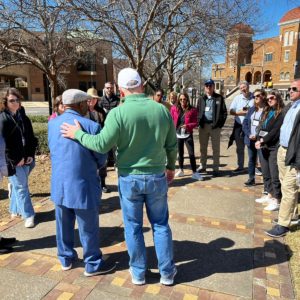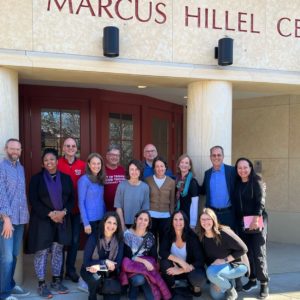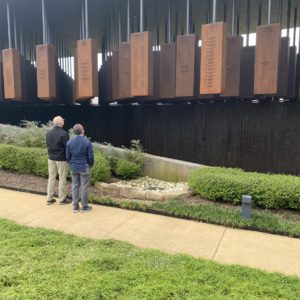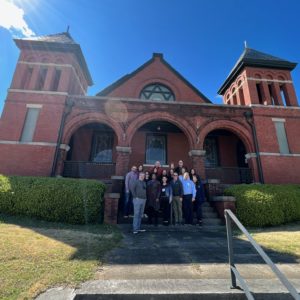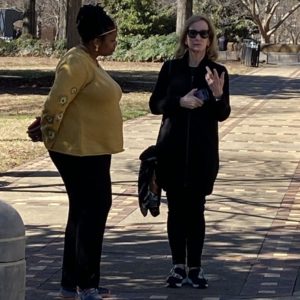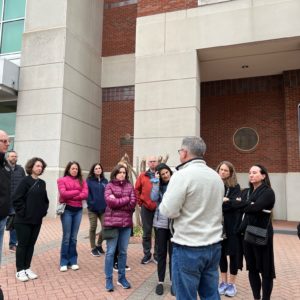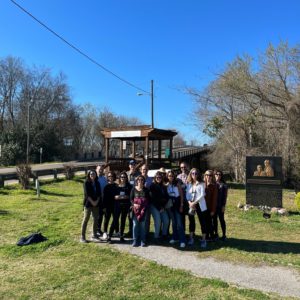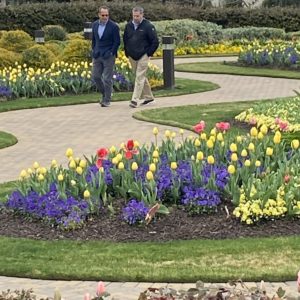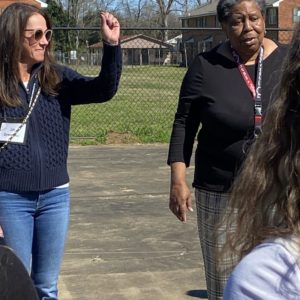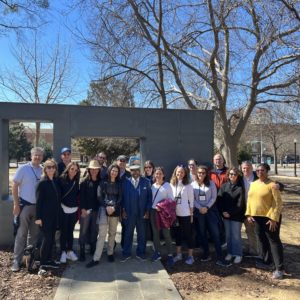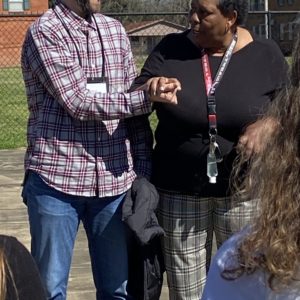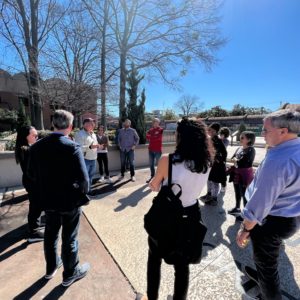-
14 March 2022
From February 28 – March 2, participants of Federation’s Community Leadership program traveled to Montgomery, Selma, and Birmingham, AL, and Atlanta, GA, to learn about America’s Civil Rights Movement. Through various site visits, lectures, and conversations, they explored their role and responsibilities as Jewish American leaders to reckon with challenging aspects of our country’s past and address the ongoing legacy of terror, violence, and slavery. Below you will find personal reflections from our mission participants about their experiences.
Learn more about the Jewish Community Leadership Program and meet program participants.
Reflections from the Participants
Marla Schulman
I flew into Atlanta from Florida to meet our group, most of whom flew in together from DC. Meeting up and getting on the bus and underway was uneventful aside from the scene of all of us swabbing our noses as soon as we boarded to test for Covid-19. The times we’re in. Two hours later we arrived in Montgomery Alabama.
I flew into Atlanta from Florida to meet our group, most of whom flew in together from DC. Meeting up and getting on the bus and underway was uneventful aside from the scene of all of us swabbing our noses as soon as we boarded to test for Covid-19. The times we’re in. Two hours later we arrived in Montgomery Alabama.
Along the way our amazing guide, Billy Planer, founder and director of Etgar 36 shared a little about his story and showed us two videos about Bryan Stevenson and his work as we prepared to tour Stevenson’s Equal Justice Initiative’s Memorial to Peace and Justice and new Legacy Museum
At the Memorial, our first stop, Gil shared with us his framing that as we embark on this journey together he suggested we think about our Jewish identities and American identities and their intersectionality.
The memorial bears witness to thousands of intentionally-titled acts of domestic terrorism. The names of black men, women and children are listed who were tortured and killed by white mobs, often as part of public lynching spectacles, for reasons as minor as looking at a white person the wrong way. As I read these names – William Rogers, Lizzie Jackson, Joseph Norman and thousands of others – I thought about how different these names would be if these peoples’ ancestors had come to this country of their own volition in search of the American dream instead of in chains. How differently their names would roll off our tongues.
Next we toured the Legacy Museum whose exhibits “draw dynamic connections across generations of Americans impacted by the tragic history of racial inequality.” I’ve been a student of the history of systemic racism and doing racial justice work for a few years now but I was blown away by the way this museum so adeptly synthesized the story from slavery to the mass incarceration problem and racial inequality we still have today.
We ended the day with dinner at our hotel and an exhausted yet energized discussion processing our day, raising important questions and not finding many answers but ready to get up again the next day to continue the journey.
Aton Teitelbaum
The day started with a sense of comradery and anticipation. When I arrived at DCA, I was excited to spend time, in person, with our cohort. We were expected to grapple with difficult issues surrounding the Jewish community through the lens of social justice. To be honest, I was excited, but also unsure of how we were going to take our learning and translate it into defining what our goal is.
The day started with a sense of comradery and anticipation. When I arrived at DCA, I was excited to spend time, in person, with our cohort. We were expected to grapple with difficult issues surrounding the Jewish community through the lens of social justice. To be honest, I was excited, but also unsure of how we were going to take our learning and translate it into defining what our goal is.
After landing, we drove the two hours to Montgomery, Alabama where we started at the Equal Justice initiative’s Memorial to Peace and Justice. When I walked into the Memorial, both the feeling I got, and the aestheticism struck very close to my experience visiting Holocaust Memorials in Poland on March of the Living over 25 years ago. We spent an hour walking through the Memorial; we walked by hundreds of hanging steel columns that list the names and dates of documented lynching’s and the counties where each lynching took place. Many of the columns were from counties I expected to see in the South. Surprisingly, there were also many that were closer to home.
After finishing at the Memorial, we went to the EJI Legacy Museum. The museum has only been open for a few months and is incredibly well done and powerful. The story and timeline of how slavery and oppression came to the US and continues today, was enhanced by the museum’s use of technology. Many of us echoed the thought that for a very well-educated group of people, there is so much we just didn’t know and understand. Or maybe, we aren’t as educated as we thought.
Yolanda led our debrief where as a group, we were very reflective and introspective about our shared experience and purpose.
It was a great start to a trip that will, no doubt, continue to educate us
Adam Ducker
Day 1
Why am I doing this?
Work is so busy. . . The kids?
Just get on the plane. . . Just go. . .
Why am I doing this?
Work is so busy. . . The kids?
Just get on the plane. . . Just go. . .
“Give yourself permission to just be in the moment” S says. . . Yeah right, just wait until the dishwasher is leaking tomorrow afternoon. . .
And then we are on the plane. . . Just gone
And then we are on the bus. . . Heading southwest from Atlanta
I am eating a tuna fish sandwich — very Jewish
Across the Chattahoochee River and in Alabama now
We are passing Tuskeegee and I am thinking about my uncle who came here (instead of going to Vietnam) as a newly minted pediatrician to work on public health issues for the poorest Americans. Black Americans
Like us (not really like us) he rode the buses even before that from New York to Alabama to sit at the lunch counters and got pummeled by the fire hose spray, blasted into the streets, beaten without hitting back to help end the injustice of his time (our time?)
Bitten by dogs, spit on by angry white kids
I wonder if that felt very Jewish. Did they call him Jew when they spit on him? I look so much like him, would they have called me Jew? Will they call me Jew?
Did his parents feel both proud and afraid when he left for Alabama? Did they try to stop him? Would I? What will I do if my kids don’t go to Alabama?
All these questions feels very Jewish too.
First stop is the National Memorial for Justice and Peace. We walk in silence zigging and zagging between the large looming stelae hanging from the concrete and weathered wood structure each with a list of names of Black Americans lynched – 4,400 of them. Maybe just a fraction of the total subject to domestic terrorism – we will discuss what the means later tonight
The building is at once so beautiful and so haunting. . . Until you turn the corner and the same steel stabs lie flat on the ground like coffins, the place reminds us of the Holocaust Memorial in Berlin. . . But different
And then The Legacy Museum: From Enslavement to Incarceration which moves our group deeply. The similarities with the Holocaust Memorial Museum and Yad Yashem are palpable, we will discuss them over dinner. But the story of enslaved Americans brings some of us to teams. We move together and eventually alone through the beautiful haunting spaces reflecting on the 400 years of horror, 12M kidnapped from their homes. Like we were
For me linking the current American crisis of incarceration with the long history of systematic racism is new and deeply troubling. Something I read somewhere challenges me. . . Everyone always says that if they were of age in the 1960s they would have boarded the buses, but who is getting on the bus to address that crisis, sadly not me
Dinner wasn’t bad at all, but the conversation afterwards lasts for hours and raises so many questions to answer in the days to come. . . Is this my story? How can it not be? How can we know so little of it? How can we do so little about it? How much have the Jews done to address it and what are the imperatives, and risks, of doing so now?
“If I am only for myself what am I?” And if not answered tonight, when? Very Jewish
Day 2
Today is about Rosa Parks and that Bridge (or the march across it) in Selma, Alabama
Or it is about leadership
And for me it’s a about being (or not being) an Upstander. . . And also being a Gawker
Today is about Rosa Parks and that Bridge (or the march across it) in Selma, Alabama
Or it is about leadership
And for me it’s a about being (or not being) an Upstander. . . And also being a Gawker
The morning starts at the Rosa Parks Museum — we are inside, outside, waiting, watching each other’s cues to navigate another unclear mask protocol – Mask on. . . Masks off. . . Masks on. . . Masks off
The Rosa Parks Museum is terrific. Mostly we are focused on the idea that change (or really leadership) just doesn’t happen in an instant. . . It’s a good story — “she was just too tired to get up and leave the white section of the bus one day. . .” But really the Montgomery Bus Boycott was meticulously planned as all the the Civil Rights movement was carefully planned. Rosa Parks was picked to be a leader – history didn’t have its eye on her — because she had done the training in civil disobedience, because she had been active in the movement for years. She was well spoken and light skinned. Masks on. . . Masks off. . .
Martin Luther King was also chosen to lead the Boycott because he was a gifted leader and orator, sure, but also because he was an out-of-towner and if it all went south someone could be blamed. An outsider. We pick leadership and leadership picks us for reasons both profound and prosaic.
The bus rolls on to Selma, which is a mythic place in America, but quite small and (we have been warned) deeply challenged economically. We have a fun lunch at the Golden Ranch where they have gone to great length to serve a kosher-style lunch for our group of twentysomething. We alternate between praising the food and joking about the calorie counts in the huge plates of fried fish, okra and hush puppies. Masks on. . . Masks off . . .
There was a Jewish Community of 300 here when Rabbi Herschel came to march arm-in-arm with Dr. King across that bridge which is somehow beautiful despite being nothing all that out of the ordinary. We go to see the synagogue in town where the four remaining Jews (the youngest is 67 we are told) don’t hold services anymore.
This is when the question about the Upstanders (distinguished from the Bystanders) starts obsessing me. For sure they were not Collaborators, thank g-d they were not Victims on those days in 1965, but did the Jews of Selma stand on these steps after shul arguing about what to do the next day that would come to be known as Bloody Sunday? The Bystanders claimed it’s not our fight, keep our heads down, let’s not make more problems than we already have. . . But were there at least a few Upstanders who did something on the sly? Delivered a meal to the marchers gathered in front of Brown’s Chapel? Did the Jewish doctor surreptitiously dress the wounds of a marcher’s head bloody from a policeman’s club? We don’t have these stories. Probably we don’t have them because they don’t exist. . . But we hope. . .
I feel like a Bystander here if I am being honest. . . And as I search for the times when I have been an Upstander. . . I can’t think of much. Mask on. . . Mask still on. . .
We are wonderfully entertained by the tour guiding antics of Joanne who tells the story of the three marches from Selma to Montgomery that drove the passage of the Voting Rights Act. But I can’t focus on anything else but the state of decay and despair of the public housing that surrounds this national monument. It feels shameful – truly substandard housing surrounding this place of national pilgrimage. Abject living conditions for these Black families who can now vote, but who 65 years later are still living in stifling poverty.
What are we doing here? Are we gawking? A bit from the Israeli poet Yehuda Amichai’s comes to me. I look up “The Tourist” on Google. . . Describing the tourists (us) looking past him at the ruins of Jerusalem he wrote, “Redemption will come only if their guide tells them ‘you see that arch from the Roman period? It’s not important: but next to it, left and down a bit, there sits a man who’s brought fruit and vegetables for his family.”
There we stand, hearing historic tales as poor Black kids play on the rickety playground in the background. Are we leaders or are we gawkers? And this is what we talk about, for hours and with true vulnerability, over a lovely dinner in a nice white suburb of Birmingham, very far really from the pitiful public housing of Selma. Masks on. . . Masks off. . . .
Wendy Feldman Block
On the closing of Black History Month, it is hard to put into words what I’ve experienced in the past two days, touring Montgomery and Selma, Alabama. I am fortunate to have been given the opportunity to participate in the Jewish Community Leadership Program through The Jewish Federation of Greater Washington. Under the leadership of the co-chairs, Josh Bernstein and Deborah Ratner Salzberg, we have come down for a Civil Rights tour of the south (Birmingham tomorrow and then onto Atlanta before heading home).
On the closing of Black History Month, it is hard to put into words what I’ve experienced in the past two days, touring Montgomery and Selma, Alabama. I am fortunate to have been given the opportunity to participate in the Jewish Community Leadership Program through The Jewish Federation of Greater Washington. Under the leadership of the co-chairs, Josh Bernstein and Deborah Ratner Salzberg, we have come down for a Civil Rights tour of the south (Birmingham tomorrow and then onto Atlanta before heading home).
The Equal Justice Initiative’s creation of this new museum as well as their National Memorial for Peace and Justice have moved me incredibly. Today, hearing from Joanne Bland, a survivor of Bloody Sunday in Selma is an experience I will never forget.
Many thoughts are swirling through my head but one thing is for sure, I’m coming back far more informed and looking to figure out how I can share my experiences and work to try and make a difference.
Marc Levitt, M.D.
Coming on this trip I knew we would be exploring the capacity humans have for evil. What I did not fully understand before was society’s endorsement of that evil.
Coming on this trip I knew we would be exploring the capacity humans have for evil. What I did not fully understand before was society’s endorsement of that evil.
This idea became quite poignant in our meeting with Carolyn McKinstry, a survivor of the 1963 Birmingham church bombing. I was struck by the fact that the very next day after the bombing, during which she lost four friends, she just went to school. And, that the bombers had been stopped by police but then allowed to continue to complete their plot. Finally, we learned that the bombers did not come to justice until decades later.
Why was this? It was due to societal acceptance and actual encouragement of this evil thru “legitimate” governmental processes.
A key moment in my personal journey in the understanding of racism was when I was giving some medical lectures in Johanesburg South Africa and a white Afrikaans man who heard of my planned visit in the subsequent days to Ghana asked why our surgical team was going there? “Didn’t we know that there we would only be helping black children?” I had never so dramatically experienced blatant racism.
Well, our team went there and helped many children and their families. While there our hosts took us to see the Gold Coast, a hub of the slave trade we all just saw depicted in the Legacy Museum in Montgomery. I saw how the slave ships were loaded to maximize their efficiency. Now this week I learned further details of that horrific effort and what it led to.
Does our society have, as Mckinstry wrote in her poignantly titled book While the World Watched a “poverty of the spirit” that allows for apathy and even, for so many, active endorsement? Why have we not learned to “live together as brothers.” Her “call for a worldwide fellowship that lifts neighborly concern beyond one’s tribe, race, class and nation is in reality a call for an all embracing and unconditional love for all man” is one that we need to make sure is heeded by us and all those we can influence. How will we now talk to our family? To our colleagues? How will what we have learned influence our purchasing and hiring practices? Where will we spend our time performing Tikun Olam?
This effort is what we must now commit ourselves to, which, to quote McKinstry again is “an absolute necessity for the survival of man.” It truly feels given the political climate we live in and with recent events in Ukraine that this call to action is happening for us right now.
It is clear that we need to figure out how to stamp out evil on both an individual level but also how to fix the systems that support it. The challenge seems insurmountable. Slow process is being made – thanks Billy for that encouragement. But so much still needs to be done.
Luckily this week I was also reminded of something else I learned on that trip many years ago to South Africa – something Nelson Mandela said about this challenge: “It always seems impossible until it’s done.”
Joshua Bernstein
Four people who turned their feelings into action most influenced my thinking thinking on this trip. Each of them is a living example of the 1963 quote from Martin Luther King:
“Darkness cannot drive out darkness, only light can do that. Hate cannot drive out hate, only love can do that.”
Four people who turned their feelings into action most influenced my thinking thinking on this trip. Each of them is a living example of the 1963 quote from Martin Luther King:
“Darkness cannot drive out darkness, only light can do that. Hate cannot drive out hate, only love can do that.”
Bryan Stevenson has devoted his professional life to righting some of the wrongs of our criminal justice system, which has disproportionately punished (mostly) black men and boys, many of whom were found guilty before any semblance of due process. He has built a moving monument to 4,000 documented lynchings that took place, not only in the South, but across our nation from 1850- 1950. The monument and nearby museum make clear that these were not isolated acts of an evil few- they were part of a system and structure designed to subjugate, demoralize and terrorize black men, women and children. They were a constant reminder to an entire race, to “stay in your place” on the bottom rung of our society and in service to the prosperity for the whites at the top.
Joanne Bland, motivated by the many indignities she experienced growing up in Selma, GA and her desire to instill hope in future generations, shared her experiences as a child who joined John Lewis and Hosea Williams in their marches across the Edmund Pettus Bridge in March, 1965 which ended in violence and tragedy. Additionally, she shared horrifying episodes from her life including the death of her mother while waiting for a blood infusion at a hospital, since there was only “white blood” available at that moment and she was not permitted to get that blood. She also told us about “colored Wednesdays”, which was the only day of the week that black children could go to the local library. Of course, these children were in school on Wednesdays. She drew our attention to the indignities, even on the memorials to slain civil rights marchers, where black men were the last to be named, behind white men and women.
With extraordinary grace and quiet presence, Carolyn McKinstry shared her life’s story, including her first hand account of the 16th St. Baptist Church bombing in September, 1963 and another across from her home eight months later. She overcame the debilitating personal effects of that trauma, to lead a life of learning, understanding and teaching that we are all God’s children. She bristles at programs that teach “tolerance”, since that is the natural state of the world. She told us that we are all born tolerant- what many of us are taught is intolerance. Her way of change making is very personal and done one human interaction at a time.
Bishop Calvin Woods Sr, told us he was “touched by God” and felt his calling to lead his congregation and the broader community to aggressively pursue freedom and justice, and to confront those standing in the way of it. Even though he suffered assault, injury and wrongful arrest, he was quick to point out that he was “a” leader among many others who sacrificed much more than he had.
This trip underscores the reality of America- past and present- that falls well short of its aspirations of equality, justice and freedom for all. We are still impacted by the insidious effects of slavery, Jim Crow discrimination, mass incarceration and restrictions on voting rights.
Listening to the courage and action of the people we met, it struck me that witnessing injustice and doing nothing is akin to participating in that injustice. I’m left grappling with these questions- “how will I turn my hope for justice into action for justice? What would I be willing to do differently to help achieve it? What would I be willing to sacrifice?”

